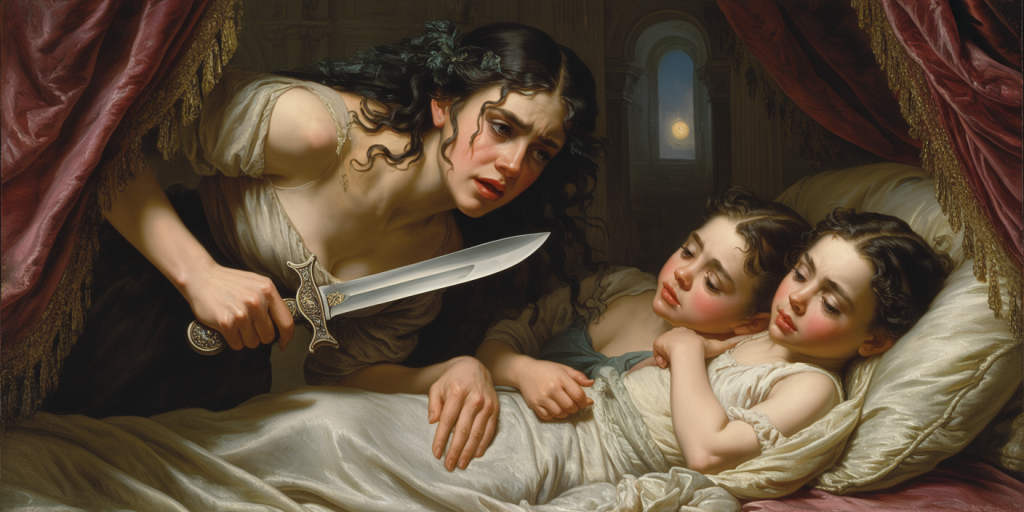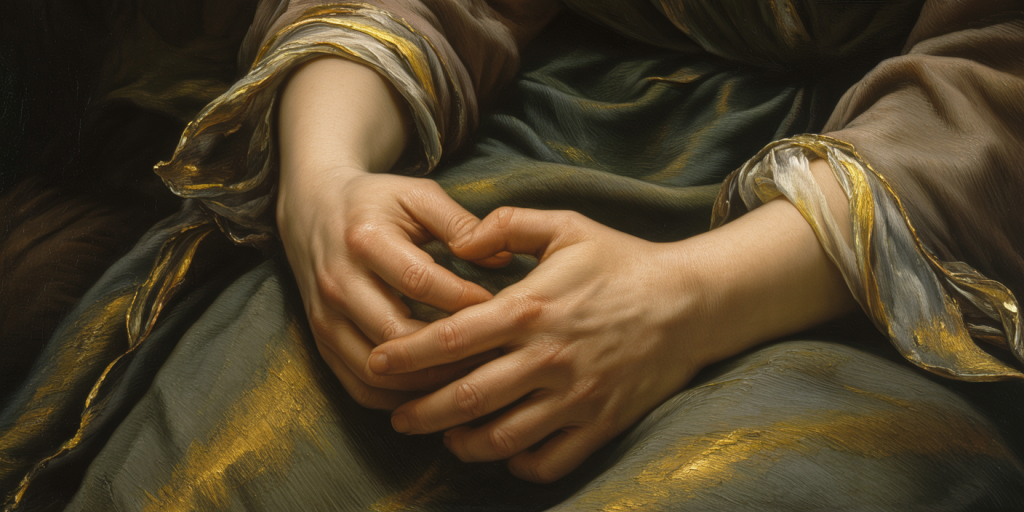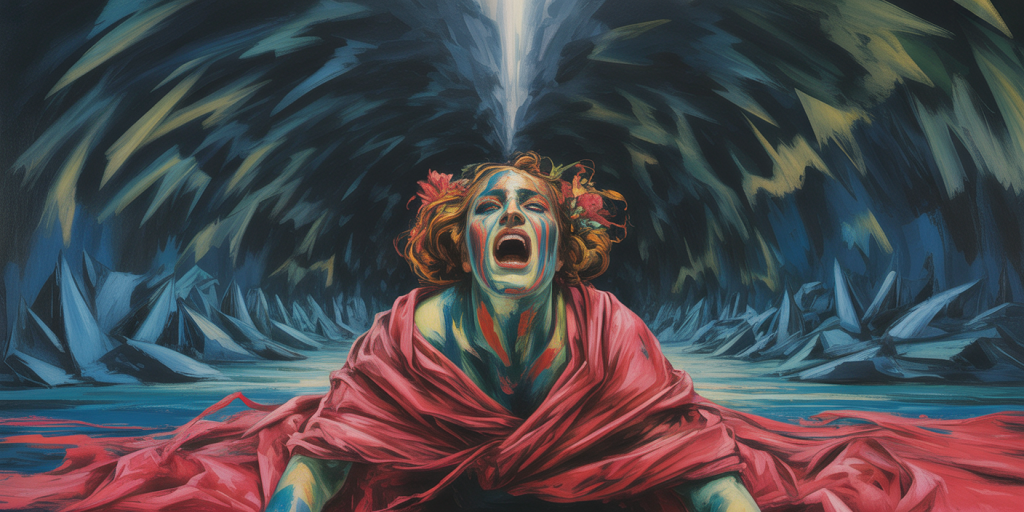Delacroix and the Lyrical Fury of Medea
A Contemplative Opening
There are paintings that whisper, and there are those that howl — that claw at the silence of the room and rip the veil between art and life. Eugène Delacroix’s “Medea About to Kill Her Children” does not simply depict a myth — it exhales it, soaked in blood, shadow, and lament. The brush trembles with torment; each stroke vibrates with the breath of a mother betrayed, abandoned, and transfigured into something eternal and terrible. The canvas is not flat — it convulses.
In this haunting tableau, the air is heavy with dread, yet also strangely melodic. It is not horror that grips us, but tragedy in its highest, most lyrical register — a kind of operatic thunder that trembles behind Medea’s frozen stance. Her eyes do not merely see; they blaze. Her arms do not cradle; they tighten, wounded and weaponized. And in the swirls of crimson and earth and flesh, Delacroix invites us not to judge, but to tremble.
Table of Contents
- The Veil of Blood and Velvet
- A Mother’s Gaze, Suspended in Ruin
- Skin Like Marble, Wrath Like Fire
- The Architecture of Tragedy
- Where Light Refuses to Console
- Tension Etched in Drapery
- Children as Symbols, Not Subjects
- Medea’s Fingers and the Idea of Possession
- The Unpainted Screams
- Palette of Betrayal
- The Echoes of Euripides
- Anatomy of a Brushstroke
- The Lioness and Her Cage
- Behind the Curtain of Madness
- Violence Poured Into Form
- The Myth Within the Myth
- A Fury Touched by Tenderness
- The Spectator as Witness
- Medea’s Silence, More Than a Cry
- The Shadow of Delacroix’s Own Soul
The Veil of Blood and Velvet
Medea is swathed not just in fabric, but in metaphor. The voluminous red cloth that encases her is more than clothing — it is an extension of her rage, a banner of warning. The color, so insistently rich, evokes not only blood but nobility, defiance, and an almost ecclesiastical grandeur. The texture appears soft and fluid, yet the gesture of her body turns it into something unyielding.
There’s a paradox in how Delacroix balances the sensuality of the fabric with the brutality of her purpose. The velvet catches light like a lover’s caress, but the act she prepares for is merciless. In this collision of softness and savagery lies the essence of Medea — a woman whose love curdled into vengeance.
A Mother’s Gaze, Suspended in Ruin
Her eyes do not meet ours, nor do they drift away — they are anchored inward, fixed on a tragic inevitability. Delacroix freezes her in the threshold between decision and act. The gaze is not passive. It is an abyss of logic and madness folding into each other.
In myth, Medea is monstrous. In Delacroix, she is human — terrifyingly, gorgeously human. Her gaze becomes a vortex that draws the viewer into complicity. We do not just watch her; we are watched by her sorrow.
Skin Like Marble, Wrath Like Fire
Medea’s arms are pale as ancient statues, their musculature defined not to emphasize beauty, but power — maternal, divine, and dreadful. The children cling to her with blind trust, unaware of the storm behind those limbs. Their flesh, in contrast, is soft, warm-toned, untouched by time or vengeance.
Delacroix crafts an anatomical tension here: Medea’s body is a battleground between reason and impulse. Her grasp is both shelter and snare. The skin may be flawless, but it pulses with fury barely contained.
The Architecture of Tragedy
The composition is a masterclass in emotional geometry. Medea is centrally placed, almost too centrally, dominating the frame like a pillar. The children curve around her like parentheses of innocence. Yet nothing feels static. The diagonals of limbs, fabric, and shadows slice through the frame, guiding the eye like a blade.
There is claustrophobia in this spatial design. No exit, no sky — just the enclosed vortex of despair. The space presses in like fate itself.

Where Light Refuses to Console
Light in this painting is not revelation but irony. It strikes Medea’s face and upper body, illuminating her just enough to unmask her torment. The children, especially the youngest, glow with softness — a cruel trick of fate that makes their presence even more painful.
This chiaroscuro is not simply Caravaggesque drama. It’s a metaphysical device: the light does not save, it exposes. It renders the act inevitable.
Tension Etched in Drapery
The folds of Medea’s dress are not decorative — they scream. Each crease and swirl is a gesture of tension. They encase her like the iron bars of an emotional prison. Her knee juts out, contorted beneath the cloth, suggesting motion frozen by sheer force of will.
The fabric, with its impossible complexity, is the visual echo of her inner turmoil. Delacroix uses drapery not just to clothe the body, but to reveal the soul.
Children as Symbols, Not Subjects
They are not portraits, these children. They are symbols — of future, of legacy, of betrayal’s final cost. Delacroix renders them tenderly, but anonymously. Their bodies curl toward Medea like petals to a sun that has turned poisonous.
There is no melodrama in their depiction, only stillness. That stillness is what lacerates — a quiet before the mythic storm.
Medea’s Fingers and the Idea of Possession
Her hands, perhaps the most expressive part of the painting, clutch the children not with brutality but with a terrifying kind of ownership. They are hers — in blood, in betrayal, in vengeance.
Delacroix paints fingers like serpents — curling, grasping, almost whispering. There is no violence yet, only its imminence. Her fingers do not strangle; they prelude.

The Unpainted Screams
What is most frightening in this painting is what it withholds. The screams are not present — neither hers nor the children’s. This is the moment before rupture, the silence that hisses.
Delacroix chooses psychological crescendo over gore. He paints not an act of murder, but its ghost — the part that lingers in the mind long after the hand is stayed or fulfilled.
Palette of Betrayal
The reds dominate, but not alone. There is ochre, deep shadow blues, decaying greens in the background — a palette of bruising, not harmony. The colors bruise the canvas as Medea’s fate bruises her soul.
Even the skin tones are muted, ghosted. No one is fully alive in this world — they are already myth, already mourned.
The Echoes of Euripides
Delacroix’s painting does not adapt Euripides — it remembers him. The echo of Greek tragedy resounds not through literal accuracy but through moral weight.
The fatalism, the divine irony, the chorus-like silence — all are embedded in the visual rhythm of the piece. Medea becomes not a character, but an ancient bell tolling through time.
Anatomy of a Brushstroke
There is violence in how Delacroix lays paint. His strokes are not clean; they shudder, especially in the background and the drapery. There’s an urgency, a refusal to tame the medium.
The hair of Medea, for instance, is wild not just in shape but in texture — it vibrates with loose, coarse strokes. The brush is a scalpel of emotion.
The Lioness and Her Cage
Medea is not merely maternal — she is animalistic. The way she crouches, the readiness in her limbs, the tension in her jaw — she is a lioness cornered.
But unlike the beast, her cage is not physical but moral. Delacroix captures the paradox: she has all the power, and no freedom.
Behind the Curtain of Madness
There is no madness in her eyes — not the clichéd kind. Rather, there is clarity, almost divine determination. She knows what she must do. That is what makes it unbearable.
Delacroix refuses the trope of the insane woman. Instead, he offers something far more chilling — a woman fully aware, fully resolved.
Violence Poured Into Form
The violence is aestheticized not to soften it, but to eternalize it. Every curve, every shadow, every color vibrates with impending rupture. The art does not recoil from horror; it gives it architecture.
This is the Romantic sublime — where beauty and terror coexist, fused by necessity.
The Myth Within the Myth
Medea here is not just the wife of Jason. She is Woman, Mother, Sorceress, Betrayed Lover, Vengeful Force. She carries centuries within her cloak. She is not one myth, but all.
Delacroix paints her not to tell a story, but to awaken an archetype. The viewer sees in her whatever they most fear — or love.
A Fury Touched by Tenderness
It is easy to forget: Medea loved. And still does. That is the horror. Her vengeance is not born of hatred alone, but of wounded devotion.
Delacroix leaves traces of this tenderness — in the way she supports the child, in the softness of their curls. It is a love so twisted it becomes fire.
The Spectator as Witness
We are not outside this painting. We are inside it, positioned as the silent chorus, helpless and paralyzed. Delacroix does not grant us distance.
This proximity is deliberate. We become part of the ethical tragedy. Our judgment, our pity, our revulsion — all are reflected in Medea’s shrouded mirror.
Medea’s Silence, More Than a Cry
There are no mouths open. No raised weapons. And yet the silence screams. It is the moment when all air vanishes from a room. It is the point at which music pauses before the crash.
Delacroix renders silence not as absence, but as the loudest sound of all.
The Shadow of Delacroix’s Own Soul
There is something autobiographical here. Delacroix was no stranger to inner fury, to the complexity of human violence. In Medea, he paints a mirror of himself — torn, brilliant, exiled from comfort.
His Romanticism was never gentle. It was always flame-colored, storm-bent. Medea is the storm he never outran.

FAQ
Who was Eugène Delacroix?
A French Romantic painter known for his expressive brushwork, bold use of color, and emotionally charged themes. He is considered a precursor to modernism and an artistic rebel in his time.
What is the painting “Medea About to Kill Her Children” based on?
It is based on the myth of Medea, particularly as dramatized by Euripides, in which the sorceress kills her children as an act of vengeance against her unfaithful husband, Jason.
Where is this painting housed?
The painting resides in the Louvre Museum in Paris.
What is significant about the style?
The work is a peak example of Romanticism — not just in subject but in brushwork, emotion, and dramatic use of light. It rejects neoclassical restraint for unfiltered human emotion.
Why didn’t Delacroix show the actual murder?
He preferred psychological tension over literal violence. The emotional intensity of the moment before the act is more disturbing — and more tragic.
The Quiet Tremor of Closing Thoughts
Delacroix’s Medea is not a painting one looks at and forgets. It is a scar, an aria, a wound immortalized in oil. It is myth reborn in flesh and shadow, where paint becomes breath and wrath becomes music. Through Medea, we confront the extremes of the human condition — not in judgment, but in awe.
In her silence, we hear the thunder of grief. In her stillness, we feel the tremor of a soul undone. And in Delacroix’s trembling brush, we find both horror and poetry, dancing at the edge of the unspeakable.
